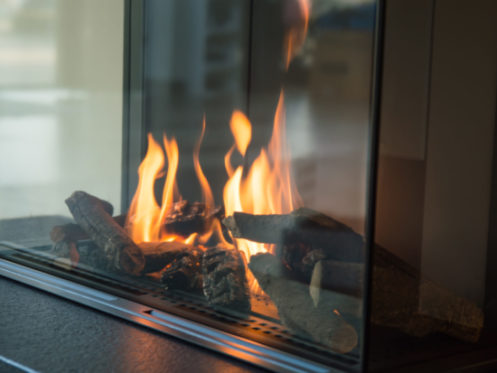There’s nothing quite like gathering around a warm, inviting fire with friends and family. Gas fireplaces add convenience to the classic fireplace experience because there is no need for logs or kindling to start the flames. However, as with anything else, certain issues can arise from improperly maintained gas fireplaces. The following are the most common issues people face when keeping their gas fireplaces in shape.
1. Pilot Light Malfunction
The pilot light’s main function is to ignite the gas when it’s time to light up the fireplace. If your pilot light is malfunctioning or has gone out completely, you won’t be able to enjoy a cozy evening in front of the fire. This issue can be caused by several factors, including clogged valves and debris blocking the flame path to worn-out thermocouples and defective valves. If any of these components don’t work well, it can cause the pilot light to act unpredictably or even go out completely.
When the pilot light malfunctions, it’s safe not to take any chances and have a professional come and take a look. They can accurately assess the situation and determine what needs to be done to get your fireplace up and running again.
2. Running Out of Fuel Too Quickly
Depending on the type of gas your fireplace runs on, you may run out of fuel much faster than expected. In most cases, this is caused by a lack of maintenance or an underlying problem with the fireplace itself. If the unit has not been serviced regularly, sediment and dirt can build up in the lines and cause blockages, leading to decreased efficiency. Additionally, if components such as burners or valves are worn out or defective, fuel could be used quickly.
Another reason could be a problem with the venting system. If the vents are blocked or not properly functioning, it can lead to heat and air pressure buildup, which can cause excessive fuel consumption. It’s best to get an expert opinion to identify and solve the issue as soon as possible.
3. Odors and Smoke
Normally, gas fireplaces should not produce any odors or smoke. If you are experiencing either of these, it could indicate something is wrong with your fireplace. One possible cause could be a back-drafting issue with too much pressure in the combustion chamber. This can lead to smoke and odor being pushed into the room instead of out of the vent stack. In addition, if something is blocking the flue or chimney, such as a bird’s nest or debris, it can also cause odors and smoke to come into the house.
During your inspection of the issue, an expert can determine if it’s a back-drafting problem or something else. Whatever the case, it’s important to address the issue as soon as possible. Not only could smoke and odors make your home uncomfortable, but they can also put you and your family at risk for health issues in the long run.
4. Difficulty Lighting the Fireplace
A gas fireplace should light up with the flip of a switch. If you’re having difficulty lighting your unit, it could be caused by several factors. One possible cause is an obstruction in the gas line, such as dirt or debris built up over time. Additionally, if any of the internal components need to be fixed, such as the igniter or thermopile, it can also make it difficult to start up your fireplace.
It could also be an issue with the gas itself. If you’re using propane, for example, and there’s a leak in the tank or line, it can cause problems when trying to light the fireplace. In this case, it’s best to avoid the area and not try to repair it yourself. Instead, contact a professional to help assess the situation and ensure it’s fixed properly and safely.
5. Gas Leaks
Gas leaks can be extremely dangerous and must be addressed with immediate effect. Some signs of a leak include sulfur-like odor, whistling or hissing noises from the fireplace or gas line, and visible bubbling around the pipe connections. If you fear a gas leak in your home, shut off the main valve and evacuate everyone from the house as soon as possible. Then, call your local fire department or an emergency plumber to come and deal with it promptly.
Gas leaks can occur for many reasons, typically due to faulty valves, improper installation, or damage to the pipes. It should never be taken lightly and should be addressed immediately by a professional experienced in dealing with these issues. It’s also important to remember that your safety is the number one priority, so never try to repair the leak yourself. If you are looking for fireplace inspection or repair services in the Wasatch Front region, look no further than Blue Best Plumbing, Heating, Air, Generators.
6. Carbon Monoxide
Carbon monoxide (CO) can be a major concern regarding gas fireplaces. This colorless and odorless gas is highly toxic and can cause serious health issues if inhaled in large amounts. Carbon monoxide leaks typically occur when there is an issue with the venting system or something blocking the flue or chimney. In these cases, air pressure builds up in the combustion chamber, which forces CO into your home instead of out through the exhaust stack.
So, how do you tell if you have a CO problem? A good indication is if there’s an increase in eye and throat irritation, headaches, nausea, or other flu-like symptoms when the fireplace is running. You should conduct regular maintenance on your unit to ensure everything is working properly and all vents are clear of any blockages to prevent this from happening. Investing in a carbon monoxide detector is highly recommended and can protect you from potential issues.
7. Cloudy Glass
If you’ve noticed that your gas fireplace’s glass has become foggy or cloudy, it could be caused by a few different factors. One cause is soot buildup, which occurs when the air-to-gas ratio is off balance, and there isn’t enough oxygen supplied to the flame. This can also happen if the exhaust fan isn’t working as it should, allowing an increase of unburned-smoke particles to enter your home.
Another possible issue is condensation buildup, often when the pilot light is left running after the fireplace has been turned off. In this case, turning off the pilot light sooner will help prevent moisture from collecting on the inside of the glass.
Finally, if you’re using a vented gas fireplace, it’s possible that the exhaust fan is not powerful enough to draw out all of the smoke generated. Regardless, it’s important to understand that gas fireplace repair is best left to a professional for your safety and well-being. If you notice any malfunction or problems with your unit, don’t hesitate to call an experienced technician and have them come and look.
8. Excess Noise
Unwanted noise from your gas fireplace could indicate several different things. If you hear a loud rumbling or buzzing sound, it may mean the fan isn’t working properly. In some cases, banging or popping noises may also occur if there is an issue with the fuel system or vents that are not allowing enough air to escape. Soot buildup can also cause the fire to produce more smoke and noise.
At Blue Best Plumbing, Heating, Air, Generators, we provide professional heating and cooling repair, installation, and maintenance to the Bountiful, UT, area. Backed by 20 years of experience, our team is ready to help with your fireplace needs. We can identify potential issues and provide a safe solution. We can also help with improving your indoor air quality. Contact us today to learn more!








